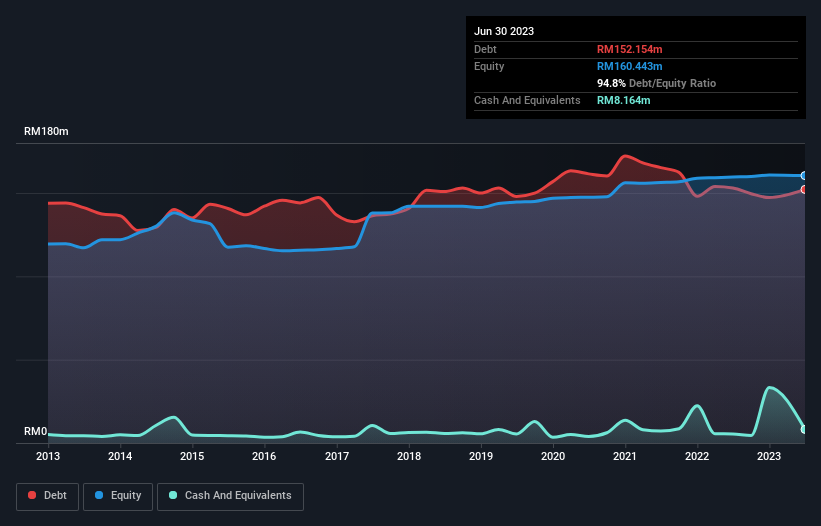Legendary fund manager Li Lu (who Charlie Munger backed) once said, 'The biggest investment risk is not the volatility of prices, but whether you will suffer a permanent loss of capital.' It's only natural to consider a company's balance sheet when you examine how risky it is, since debt is often involved when a business collapses. As with many other companies Rapid Synergy Berhad (KLSE:RAPID) makes use of debt. But is this debt a concern to shareholders?
Why Does Debt Bring Risk?
Generally speaking, debt only becomes a real problem when a company can't easily pay it off, either by raising capital or with its own cash flow. Part and parcel of capitalism is the process of 'creative destruction' where failed businesses are mercilessly liquidated by their bankers. However, a more usual (but still expensive) situation is where a company must dilute shareholders at a cheap share price simply to get debt under control. Of course, debt can be an important tool in businesses, particularly capital heavy businesses. When we think about a company's use of debt, we first look at cash and debt together.
Check out our latest analysis for Rapid Synergy Berhad
How Much Debt Does Rapid Synergy Berhad Carry?
As you can see below, Rapid Synergy Berhad had RM152.2m of debt, at June 2023, which is about the same as the year before. You can click the chart for greater detail. On the flip side, it has RM8.16m in cash leading to net debt of about RM144.0m.

A Look At Rapid Synergy Berhad's Liabilities
Zooming in on the latest balance sheet data, we can see that Rapid Synergy Berhad had liabilities of RM77.2m due within 12 months and liabilities of RM97.3m due beyond that. On the other hand, it had cash of RM8.16m and RM17.6m worth of receivables due within a year. So its liabilities total RM148.8m more than the combination of its cash and short-term receivables.
Given Rapid Synergy Berhad has a market capitalization of RM2.65b, it's hard to believe these liabilities pose much threat. However, we do think it is worth keeping an eye on its balance sheet strength, as it may change over time.
We measure a company's debt load relative to its earnings power by looking at its net debt divided by its earnings before interest, tax, depreciation, and amortization (EBITDA) and by calculating how easily its earnings before interest and tax (EBIT) cover its interest expense (interest cover). Thus we consider debt relative to earnings both with and without depreciation and amortization expenses.
Rapid Synergy Berhad shareholders face the double whammy of a high net debt to EBITDA ratio (9.7), and fairly weak interest coverage, since EBIT is just 1.2 times the interest expense. The debt burden here is substantial. The good news is that Rapid Synergy Berhad improved its EBIT by 6.1% over the last twelve months, thus gradually reducing its debt levels relative to its earnings. The balance sheet is clearly the area to focus on when you are analysing debt. But it is Rapid Synergy Berhad's earnings that will influence how the balance sheet holds up in the future. So if you're keen to discover more about its earnings, it might be worth checking out this graph of its long term earnings trend.
Finally, while the tax-man may adore accounting profits, lenders only accept cold hard cash. So it's worth checking how much of that EBIT is backed by free cash flow. Over the most recent three years, Rapid Synergy Berhad recorded free cash flow worth 60% of its EBIT, which is around normal, given free cash flow excludes interest and tax. This cold hard cash means it can reduce its debt when it wants to.
Our View
We weren't impressed with Rapid Synergy Berhad's net debt to EBITDA, and its interest cover made us cautious. On the other hand, we found comfort in its relatively strong conversion of EBIT to free cash flow. Looking at all this data makes us feel a little cautious about Rapid Synergy Berhad's debt levels. While debt does have its upside in higher potential returns, we think shareholders should definitely consider how debt levels might make the stock more risky. The balance sheet is clearly the area to focus on when you are analysing debt. But ultimately, every company can contain risks that exist outside of the balance sheet. We've identified 4 warning signs with Rapid Synergy Berhad (at least 1 which is a bit concerning) , and understanding them should be part of your investment process.
When all is said and done, sometimes its easier to focus on companies that don't even need debt. Readers can access a list of growth stocks with zero net debt 100% free, right now.
New: AI Stock Screener & Alerts
Our new AI Stock Screener scans the market every day to uncover opportunities.
• Dividend Powerhouses (3%+ Yield)
• Undervalued Small Caps with Insider Buying
• High growth Tech and AI Companies
Or build your own from over 50 metrics.
Have feedback on this article? Concerned about the content? Get in touch with us directly. Alternatively, email editorial-team (at) simplywallst.com.
This article by Simply Wall St is general in nature. We provide commentary based on historical data and analyst forecasts only using an unbiased methodology and our articles are not intended to be financial advice. It does not constitute a recommendation to buy or sell any stock, and does not take account of your objectives, or your financial situation. We aim to bring you long-term focused analysis driven by fundamental data. Note that our analysis may not factor in the latest price-sensitive company announcements or qualitative material. Simply Wall St has no position in any stocks mentioned.
About KLSE:RAPID
Rapid Synergy Berhad
An investment holding company, engages in manufacturing and sale of precision tools, dies, and molds for the semiconductor, electrical, and electronics industries in Malaysia, rest of Asia, and North Africa.
Proven track record with mediocre balance sheet.
Market Insights
Community Narratives



